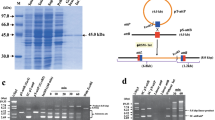Abstract
The int gene of bacteriophage HK022, coding for the integrase protein, was cloned in a mammalian expression vector downstream of the human cytomegalovirus (CMV) promoter. Green monkey kidney cells (COS-1) and mouse embryo fibroblast cells (NIH3T3) transiently transfected with the recombinant plasmid express the integrase protein. Co-transfection of this plasmid with reporter plasmids for site-specific recombination and PCR analyses show that the integrase promotes site-specific integration as well as excision. These reactions occurred without the need to supply integration host factor and excisionase, the accessory proteins that are required for integrase-promoted site-specific recombination in vitro as well as in the natural host Escherichia coli.
Similar content being viewed by others
References
Abremski K & Gottesman S (1981) J. Mol. Biol. 153: 67–78
Ausubel F, Bernt R, Kingston RE, Moore DD, Seidman JG, Smith JA & Struhl K (1987) Current Protocols in Molecular Biology. J. Wiley & Sons, Inc., New York
Craig NL (1988) Annu. Rev. Genet 22: 77–105
Dorgai L, Sloan S & Weisberg RA (1998). J. Mol. Biol. 277: 1059–1070
Dorgai L, Yagil E & Weisberg R (1995) J. Mol. Biol. 252: 178–188
Gluzman Y (1981) Cell 23: 175–182
Goodman SD, Nicholson SC & Nash HA (1992) Proc. Natl. Acad. Sci. USA 89: 11910–11914
Hirt B (1967) J. Mol. Biol. 26: 365–369
Jainchill JL, Aaronson SA & Todaro GJ (1969) J. Virol. 4: 549–553
Kilby NJ, Snaith MR & Murray JAH (1993) TIG 9: 413–421
Kolot M, Gottfried P & Yagil E (1996) Mol. Gen. Genet. 253: 362–369
Kolot M & Yagil E (1994) Mol. Gen. Genet. 245: 623–627
Landy A (1989) Annu. Rev. Biochem. 58: 913–949
Landy A (1993) Curr. Opin. Genet. Dev. 3: p. 699–707
Nagaraja R & Weisberg RA (1990) J. Bacteriol 172: 6540–6550
Nash HA (1983) Methods Enzymol. 100: 210–216
Pluck A (1996) Int. J. Exp. Pathol. 77: 269–278
Rajewsky K, Gu H, Kuhn R, Betz UA, Muller W, Roes J & Schwenk F (1996) J. Clin. Invest. 98: S51–3
Rossant J & Nagy A (1995) Nat. Med. 1: 592–594
Sadowski PD (1993) FASEB J. 7: 760–767
Sambrook J, Fritsch EF & Maniatis T (1989) Molecular cloning: a laboratory manual. Cold Spring Harbor Laboratory, Cold Spring Harbor, N.Y.
Sauer B (1993) Methods Enzymol. 225: 890–900
Sauer B (1994) Curr. Opin. Biotechnol. 5: 521–527
Sauer B & Henderson N (1988) Proc. Natl. Acad. Sci. USA 85: 5166–5170
Sauer B & Westphal H (1996) In: Lonai P (ed.) (pp 373–382) Harwood Academic Publishers, Amsterdam
Segall AM, Goodman SD & Nash HA (1994) EMBO J. 13: 4536–4548
Yagil E, Dolev S, Oberto J, Kislev N, Ramaiah N & Weisberg RA (1989) J. Mol. Biol. 207: 695–717
Yagil E, Dorgai L & Weisberg R (1995) J. Mol. Biol. 252: 163–177
Author information
Authors and Affiliations
Rights and permissions
About this article
Cite this article
Kolot, M., Silberstein, N. & Yagil, E. Site-specific recombination in mammalian cells expressing the Int recombinase of bacteriophage HK022 – Site-specific recombination in mammalian cells promoted by a phage integrase. Mol Biol Rep 26, 207–213 (1999). https://doi.org/10.1023/A:1007096701720
Issue Date:
DOI: https://doi.org/10.1023/A:1007096701720




